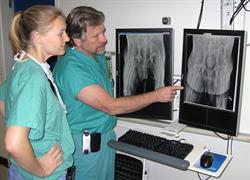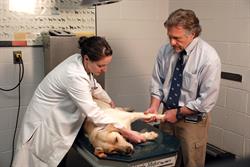 The Penn Hip Improvement Program, largely known as PennHIP, has had a fascinating and successful trajectory from lab to private sector patient care. Rigorously developed by Dr. Gail K. Smith, V’74, the program exemplifies the cross-disciplinary nature of work at Penn Vet—drawing not only from veterinary but engineering principles. But as Smith notes, “From the beginning, it’s always been about the welfare of dogs.”
The Penn Hip Improvement Program, largely known as PennHIP, has had a fascinating and successful trajectory from lab to private sector patient care. Rigorously developed by Dr. Gail K. Smith, V’74, the program exemplifies the cross-disciplinary nature of work at Penn Vet—drawing not only from veterinary but engineering principles. But as Smith notes, “From the beginning, it’s always been about the welfare of dogs.”
Canine Hip Dysplasia (CHD) is a heritable disease that afflicts millions of dogs each year and is a major concern for pet owners, breeders, working dog owners, and veterinarians. CHD is described as the faulty development of the hip, causing excessive wear to joint cartilage; it affects all dog breeds and more than 50 percent of dogs in some of the major breeds. Excessive hip joint laxity leads to osteoarthritis (OA), stiffness, and diminished quality of life, and costs owners and breeders millions of dollars in care and loss of performance. The emotional toll is incalculable.
While CHD has been described since the 1930s, Smith’s pioneering research has advanced the ability of veterinarians to identify and treat the condition early in life. PennHIP is a unique method enabling the estimation of OA risk in dogs as young as 16 weeks of age.
PennHIP includes three major components: a diagnostic radiographic technique; a network of trained veterinarians; and a medical database for scientific analysis. The multifaceted radiographic screening method assesses the quality of the canine hip and quantitatively measures canine hip joint laxity. Approximately 3,000 veterinarians around the world are trained to perform the PennHIP methodology.
 Smith charted a distinctive academic path at Penn, which led to groundbreaking work. After completing an undergraduate degree in engineering in 1970, he was interested in pursuing bioengineering, which was not an academic discipline at the time. He was accepted into the VMD-PhD program in 1971 and, after receiving his Penn Vet degree in 1974, went on to earn a PhD in materials science engineering. He completed a residency in orthopedic surgery in 1979 and was appointed to the Penn Vet faculty that same year.
Smith charted a distinctive academic path at Penn, which led to groundbreaking work. After completing an undergraduate degree in engineering in 1970, he was interested in pursuing bioengineering, which was not an academic discipline at the time. He was accepted into the VMD-PhD program in 1971 and, after receiving his Penn Vet degree in 1974, went on to earn a PhD in materials science engineering. He completed a residency in orthopedic surgery in 1979 and was appointed to the Penn Vet faculty that same year.
As Smith explains, “I chose the veterinary curriculum over medical school because it provided more opportunity for multi-species investigation: the One Health concept.”
In the McKay Laboratory in the School of Medicine, he conducted in vitro biomechanical research on the hip, knee, and spine. In 1983, this research led to a theory that became the scientific foundation for PennHIP. It was here that the “surgery, materials, and mechanics all came together,” Smith recalls. “We could understand hip health with a high degree of accuracy and clinical relevance.” In 1993, the PennHIP method was made available to the public as a clinical tool to aid in the control of CHD. In 1996, Smith was issued a patent for the discovery; a second followed in 2013.
A large scientific database houses the PennHIP data. As more information becomes available, the PennHIP laboratory is able to obtain more precise answers to questions about the etiology, prediction, and genetic basis of hip dysplasia. PennHIP publishes its findings in scientific journals to share with veterinarians, as well as breed clubs and dog fancy publications. The tools developed by PennHIP help veterinarians and dog breeders to reduce or eliminate CHD through selective breeding strategies.
 With 20 years of science and 45 peer-reviewed papers to back the PennHIP findings, Smith’s work has not gone unnoticed. For his research and contributions to the advancement of small animal veterinary medicine, Smith has been recognized by the American Veterinary Medical Association and the American Kennel Club. He has also received the prestigious Blaine Award from the British Small Animal Veterinary Association and the Iams Saki Paatsama Award from the World Small Animal Veterinary Association.
With 20 years of science and 45 peer-reviewed papers to back the PennHIP findings, Smith’s work has not gone unnoticed. For his research and contributions to the advancement of small animal veterinary medicine, Smith has been recognized by the American Veterinary Medical Association and the American Kennel Club. He has also received the prestigious Blaine Award from the British Small Animal Veterinary Association and the Iams Saki Paatsama Award from the World Small Animal Veterinary Association.
In the 1990s, the Penn Center for Innovation (PCI) licensed PennHIP to a corporation, with Smith taking it back in 2002 and turning it into a not-for-profit service at Penn Vet. Recently, PCI facilitated the sale of PennHIP to Antech Imaging Services (Antech Diagnostics, Inc.): it is now called AIS PennHIP.
As the Director of AIS PennHIP, Smith helps Antech develop web-based teaching modules for an untapped market: everyday pet owners. Tom Gregor and Dr. Pamela McKelvie, longtime members of the PennHIP team, also work for AIS with Smith. Their goal is for this new educational platform to facilitate global training of new PennHIP veterinarians and to make PennHIP information accessible and convenient for dog owners, as well as breeders and vets.
“I’m looking forward to PennHIP growing rapidly,” Smith says. “Pain medication for life, even hip replacements, are compromises and cost a lot of money. People would like their dogs to have good hips. Now they’ll be able to measure the risk of their dog developing hip OA and, with their veterinarian’s guidance, implement preventive and palliative
strategies early in life.”